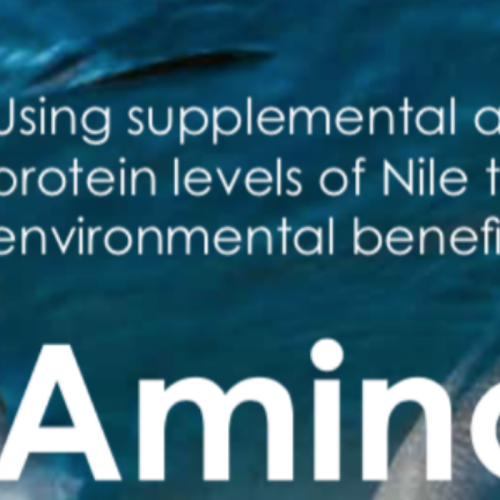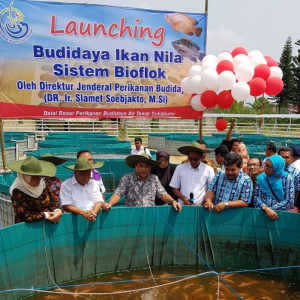
Using Supplemental Amino Acids to Reduce Dietary Protein Levels of Nile Tilapia Gives Economic and Environmental Benefits
| Wed, 22 Apr 2020 - 08:41
World finfish aquaculture production has been progressively rising, and now accounts for almost 47 percent of total fish production. On a global scale, tilapia are the second most cultivated finfish group, with Nile tilapia (Oreochromis niloticus) accounting for eight percent of total finfish produced in 2016. The species is particularly popular due to its fast‐growing rates, disease resistance, robustness and ability to adapt to different farming systems.
In aquaculture, feed accounts for 50 percent of total production cost. A major challenge is to find new strategies for precision diet formulation that minimise feed cost, while increasing sustainability. Feed cost is largely determined by dietary protein sources and inclusion levels.
In the past few years, advances in the knowledge of tilapia nutrition, and commercial availability of supplemental amino acids have allowed feed producers to be flexible in utilising plant sources to formulate balanced diets. In addition to enabling industry to implement zero fishmeal diets, supplemental amino acids open windows to reduce the dietary protein levels while balancing the diet for amino acid levels.
In the swine and poultry industries, the low protein concept with the use of supplemental amino acids has been a common practice for a long time. In aquaculture, this concept is not as common, and protein quantity is still used as an indicator of diet quality. However, diet quality is rather determined by the protein quality and not quantity.
This requires additional attention on quantitative and qualitative amino acid levels. Nile tilapia's response to dietary protein levels has been widely studied and is dependent on fish size/age, dietary amino acid profile and digestibility.
Typically, Nile tilapia starter or fry diets contain 45 percent crude protein, while the diet for fingerlings and advanced juveniles' optimal growth performance contain 35 percent crude protein. For adults, 25-30 percent protein is commonly used. Diets with high levels of protein but with an imbalanced amino acid profile will result in increased amino acid catabolism and consequently higher nitrogen losses.
Given the production volume of tilapia and the expected growth of aquaculture as a strategy to feed nine billion people by 2050, it is essential to find diets that are cost‐effective and environmentally sustainable.
We conducted a study to reduce protein inclusion levels in plant protein‐based diets for juvenile Nile tilapia, through adequate amino acid supplementation, in order to minimise dietary environmental impact while maximising biological efficiency. Furthermore, metabolic trials were performed aiming to obtain an in vivo snapshot of protein utilisation in Nile tilapia juveniles as a function of dietary protein content.
Materials and methods
Experimental diets
Five isoenergetic diets were formulated with differing protein levels (36%, 34%, 32%, 30% and 28% diet), using plant ingredients as well as meat and bone meal as protein sources. Diets were formulated to meet the minimum requirements of amino acids, on digestible basis, for Nile tilapia juveniles according to AMINOTilapia (a tool developed by Evonik for the amino acid recommendations of Nile tilapia).
Apparent digestibility coefficients (ADC) of amino acids for the ingredients used were taken from our review report (Konnert and Masagounder 2017). Diets were supplemented with increasing levels of selected indispensable amino acids and di‐calcium phosphate with the decreasing levels of dietary protein to avoid amino acid or mineral imbalances.
Growth trial
Nile tilapia juveniles with an average body weight of 5.91 ± 1.66g were used and the experiment was conducted at CCMAR in Portugal.
Triplicate tanks were randomly assigned to one of the five dietary treatments (D36, D34, D32, D30 and D28). Fish were fed to visual satiety by hand, three times a day (09:30, 12:30 and 16:30 hours). Water quality parameters were monitored daily: temperature averaged 25.2 ± 0.1°C, dissolved oxygen in water was maintained above 80 percent of saturation, pH was maintained between 7.70 and 8.20 and the concentration of unionised ammonia and nitrites in water was 0 mg/l during the whole experimental period. Fish were monitored daily for any mortality and feed intake was recorded daily for 59 days.
Metabolic trial
After the growth trial, fish from the higher, intermediate and lower protein dietary treatments (D36, D32 and D28) were randomly selected and transferred to the nutrient flux laboratory. The experimental diets were labelled with [U-14C]-L-amino acid mixture
Tube-feeding was performed on anesthetised fish, which were then transferred into individual incubation chambers connected to CO2 traps (Rust et al. 1993; Rønnestad et al. 2001). Each chamber was hermetically sealed and supplied with a gentle oxygen flow during the 24 hours of incubation. At the end of the incubation period, each fish was weighed and filleted for determining radioactivity in the muscle.
Results and discussion
Growth performance and feed utilisation
All fish had a fivefold increase in body weight at the end of the experiment, independently of the diet, and no significant differences (p > .05) were found at the end of the experiment, with mean values ranging from 29.34 to 31.49g.
Fish weight gain was not influenced (p > .05) by the different dietary protein levels. Feed conversion ratio (FCR) increased with decreasing levels of dietary protein but differed significantly (p < .05) only between the group fed D28 (1.30 ± 0.05) and those fed the D36 diet (1.16 ± 0.05). Protein efficiency ratio (PER) increased with decreasing levels of dietary protein; therefore, the D28 group presented the highest PER (2.60 ± 0.09) and the D36 presented the lowest (2.27 ± 0.09).
The groups fed D28, D30 and D32 diets exhibited no significant differences among them (p > .05) and were significantly different from the group fed the D36 diet (p < .05). No differences were detected among treatments concerning the daily voluntary feed intake. There were no significant differences (p > .05) in survival among fish fed the experimental diets, which in overall was 98 ± 3 percent.
Dietary protein utilisation
Fish fed the D30 diet exhibited higher body protein retention than those fed the D36 diet (41 vs. 36% of intake, p < .05). The retention of the majority of the amino acids followed a similar pattern to that of protein retention, with fish fed the D30 diet presenting a tendency for higher retention values than those fed the D36 diet.
The exception to this trend was methionine, which presented the highest retention in fish fed the D36 diet, although no significant differences were found between the D36 and the D30 treatments (p > .05). This is because as the protein level decreased in the diets from 36 to 28%, cysteine (Cys) level declined from 0.53 to 0.44 percent, which resulted in Met+Cys (1.33-1.35%) being more limiting than Met (0.82-0.89%) per se.
Due to the limitation of Cys in the low protein diets, fish more likely used Met as a precursor for Cys production to meet other metabolic needs than for direct protein synthesis, explaining the reduced Met retention in fish fed the low protein diets.
Daily nitrogen gain was similar among treatments, but there were significant differences concerning the values of daily nitrogen losses. Fish fed low‐protein diets, D28 and D30, presented the lowest daily nitrogen loss although only significantly different from the D36 group (p < .05).
The results of the metabolic trials gave an in vivo snapshot on how dietary protein was being utilised by the fish. The highest values of amino acid catabolism were found for fish fed the D36 diet and the values showed a declining trend as the dietary protein level declined. Mirroring N gain, relative amino acid retention in muscle (mg / g fish) was quite similar among treatments and no significant differences were found.
The present work indicates that the excessive dietary protein content ultimately results on the use of amino acids as energy source and consequently on higher environmental impacts, due to increased nitrogen outputs.
Conclusions
In conclusion, the present study demonstrates that it is possible to reduce protein levels in juvenile Nile tilapia diets to 30-32 percent without compromising fish growth and FCR, while reducing nitrogen losses to the environment. Using appropriate amino acid supplementation in tilapia feed seems an advisable strategy to minimise dietary protein levels, and guarantee economic and environmentally sustainable tilapia production.
Source: Aquafeed






















